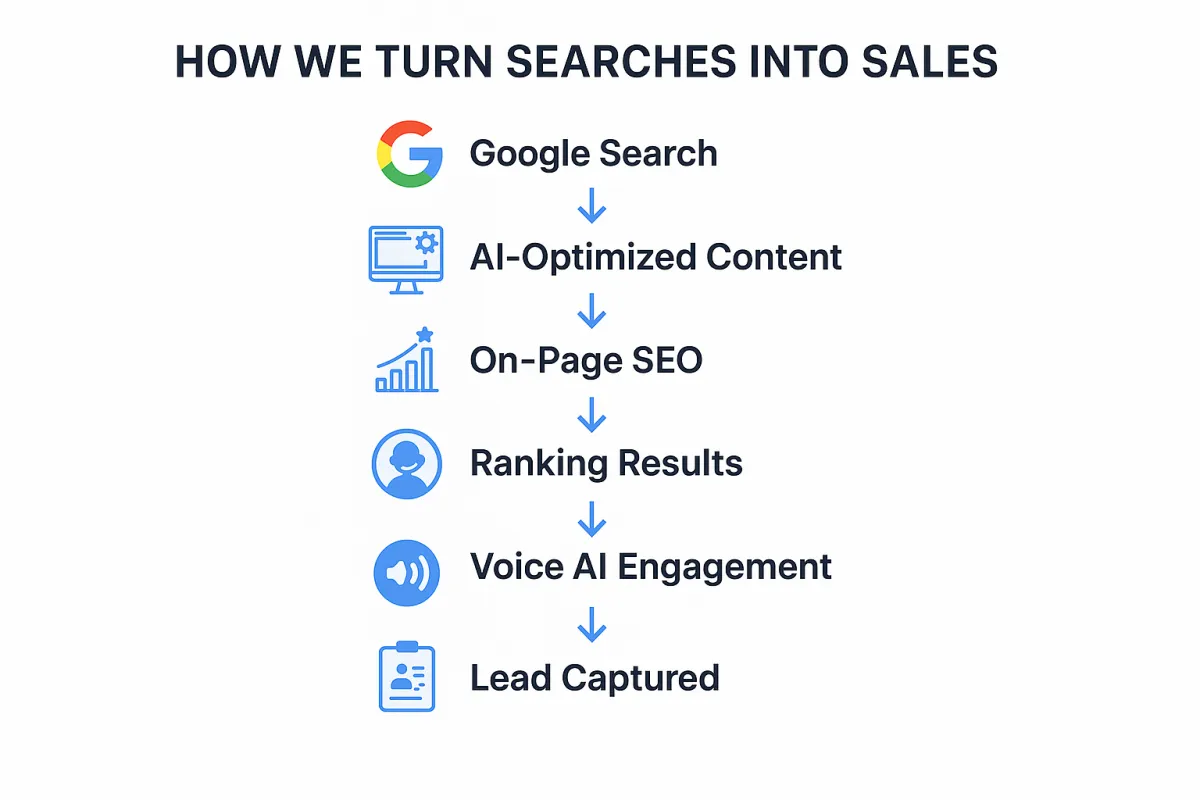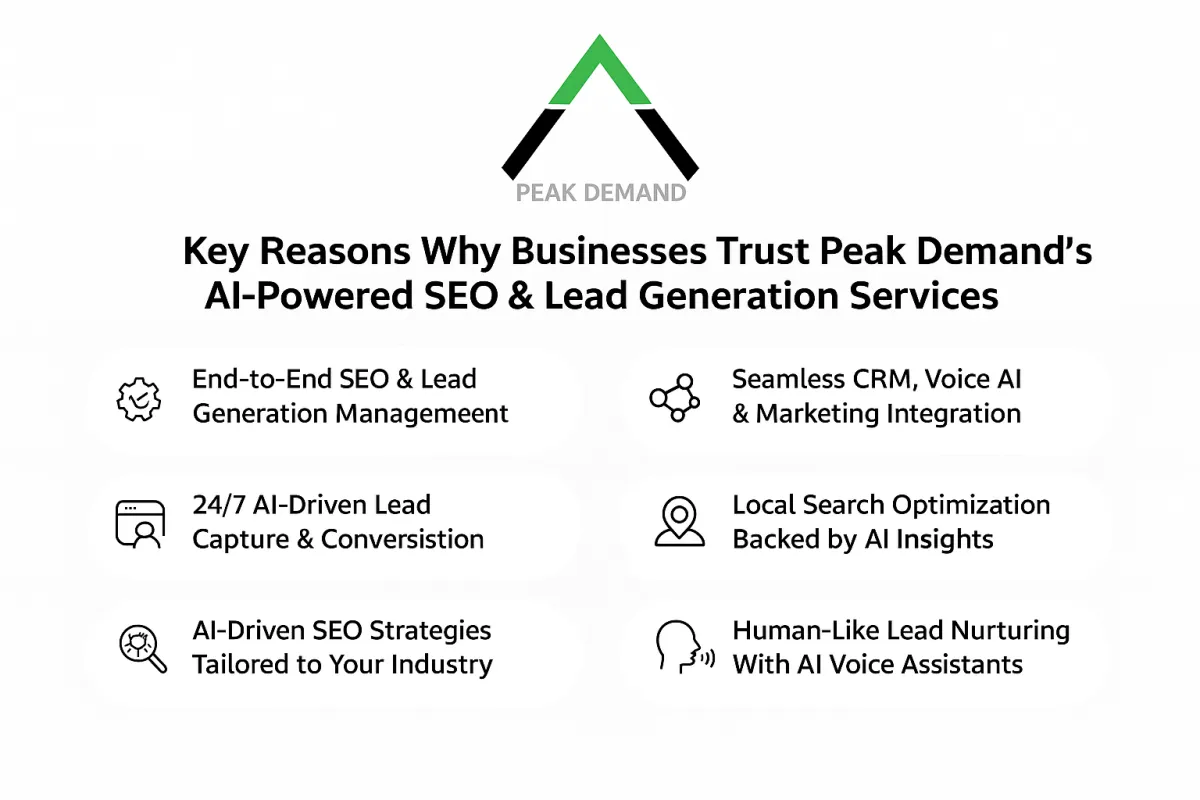AI Agency Automation Services & SEO
Toronto, Ontario, Canada
Let's climb to the top of your market, one custom automation at a time.
Phone: +1 (647) 691-0082
Email: [email protected]
Automated Voice AI Call Centre Using AI Agents with Personality
Agents that Work 24/7 - No Hold Times
Dedicated Phone Numbers
Speak to Multiple Customers
Speak in Multiple Languages
Customized Personality and Accents
Trained On Any Service or Document
Book Appointments Onto Calendars
Update CRM After Data Extraction
Provide Post Call Reports
Never Take Breaks
Never Get Tired
Never Retire
Customer Service Operations, Technical Support, Sales, After Hours
AI News, AI Updates, AI Guides

Losing Big: Canada Fell Behind in the AI Race — No Signs of Recovery with Max Fear & Red Tape
Losing Big: Canada AI Frontier — No Signs of Recovery

Canada helped build modern AI—but we’re losing big right as rivals accelerate. Fear, red tape, and policy limbo are freezing AI adoption and pushing real deployment further out of reach.
A Canadian Press report shows AI-generated hate and deepfakes are spreading while rules lag. One watchdog put it bluntly: “We have no safety rules at all… no way of holding [platforms] accountable whatsoever.” In Ottawa, the last attempt to tackle online harms died with prorogation; the justice minister now promises a “fresh” look, and the new AI ministry says it’s better to get regulation right than to rush. Translation: more waiting—while risks grow and procurement stalls.
Economically, the leak is obvious. Canada hosts ~10% of the world’s top-tier AI researchers, yet only 7% of IP from the Pan-Canadian AI Strategy is owned by Canadian private firms, and just 0.7% of 2023–24 funding for AI-native startups landed here. Talent is here; value capture isn’t.

This isn’t a choice between safety and speed. It’s a sequencing problem. Build while we regulate—with auditable, compliant use cases (e.g., 24/7 voice AI receptionists for booking, intake, and follow-ups) that boost productivity today, even as stricter rules on harmful content come online later.
AI adoption Canada: Fear and Red Tape Are Choking Growth

Canada’s AI debate is dominated by safety headlines and policy limbo, and it’s freezing deployment. Front-line advocates call today’s environment “weaponized”—“the harms aren’t artificial—they’re real.” Meanwhile, officials keep promising a “fresh look” at online-harms rules, but every month without clarity teaches executives to wait.
Here’s how that plays out on the ground:
Legal uncertainty: teams can’t tell what’s allowed, so pilots stall in review loops.
Platform accountability void: hateful deepfakes spread, reputational risk spikes, and risk committees veto launches.
Procurement paralysis: public buyers fear headlines more than missed KPIs, so compliant projects get parked.
The paradox: we over-index on fear at the expense of productivity. It is now “really accessible to almost anybody” to create convincing AI video—raising public anxiety—yet we’re not pairing that reality with clear guardrails and fast lanes for compliant builders. Until we do, Canada bleeds time, talent, and momentum—and businesses keep paying the cost in missed bookings, slower service, and lower output.
AI regulation Canada & Online Harms Act: Policy Limbo vs. Deployment

Canada’s rules are stuck between urgency and hesitation. Bills meant to tackle harmful online content and set a regulatory AI framework died when Parliament was prorogued in January. In June, the justice minister said Ottawa will take a “fresh” look at the Online Harms Act, while the new AI ministry argued it’s better to get regulation right than to move too quickly. Translation: months more waiting while risks grow and projects stall.
The harms are real—and rising. Advocates report AI-generated hate spreading across platforms, with LGBTQ+, Jewish, Muslim, and other communities targeted. One watchdog warned, “We have no safety rules at all… no way of holding [platforms] accountable whatsoever.” Another noted, “The harms aren’t artificial—they’re real.” The government has signalled plans to criminalize distribution of non-consensual sexual deepfakes, and to learn from the EU and UK. But intent isn’t deployment.
Policy limbo has a cost:
Teams can’t tell what’s allowed, so launches get trapped in review cycles.
Public buyers fear headlines more than missed KPIs, freezing AI adoption.
Founders seek clearer regimes abroad, taking compute, capital, and IP with them.
The fix isn’t “safety or speed”—it’s safety and speed in parallel. Canada needs enforced takedowns and platform duties while giving compliant builders a fast lane: DPIA-by-template, consent logging, audit trails, and sector playbooks. Do that, and practical deployments—like 24/7 voice AI receptionists for booking, intake, and follow-ups—can ship now without waiting for the perfect law.
AI deepfakes Canada & AI safety: Real Harms, Worse Incentives

AI video is now cheap, fast, and viral—fuel for outrage and copycats. Recent Canadian coverage shows hate-bait deepfakes pulling hundreds of thousands of views, targeting LGBTQ+, Jewish, Muslim, and other communities, while rules lag. Experts warn the tools to make this content are widely accessible, and current detection is probabilistic—it misses things. Result: platforms over-reward engagement; society pays the cost.
Here’s the incentive problem in plain terms:
Platforms gain on outrage. Engagement ≠ truth; the spiciest clips travel farthest.
Executives see headline risk, not ROI. They stall benign AI deployments to avoid blowback.
Bad actors learn the playbook. Low cost + high reach = more attempts.
What Canada should do next (without freezing adoption):
Duty to act: platform-level flagging, takedown SLAs, auditable transparency reports.
Provenance by default: watermarking/content credentials for AI video; penalties for stripping.
Targeted criminalization: non-consensual sexual deepfakes and incitement—clear, enforceable.
Brand-safety pressure: advertisers opt into verified-provenance inventory only.
What businesses can ship now (safe, auditable, productive):
Deploy 24/7 voice AI receptionists for intake/booking with consent capture, call logs, and retention controls.
Add brand-safety guardrails (blocklists, human review for sensitive terms) around customer-facing content.
Maintain an incident playbook: detect → freeze → review → notify → remediate.
This keeps the spotlight on real harms and perverse incentives—and shows a path to ship practical, low-risk AI while stronger platform accountability comes online.
AI productivity Canada & Canadian economy AI: The Cost of Waiting

Productivity is paycheques. Every month Canada hesitates on AI, we trade higher wages for flat output and slip further behind economies that are shipping, not stalling.
The losses are daily and compounding. Missed calls, long hold times, slow intake, and manual follow-ups bleed revenue across clinics, trades, and services. A 24/7 voice AI receptionist fixes the basics—answer, qualify, book, and follow up—so the same staff produce more per hour.
Value capture is drifting abroad. Canada trains world-class researchers, but too much IP, funding, and scaling land elsewhere. Recent analysis shows Canada gets a tiny share of new AI-native funding while the U.S. and China capture the overwhelming majority—meaning the jobs, IPOs, and spillover effects concentrate there, not here.
Compute slows the clock. Scarce, expensive GPU access and unpredictable queues stretch build cycles. Teams either downscope models, accept delays, or relocate workloads—none of which boosts Canadian output.
Procurement delay kills ROI. When compliant pilots take quarters to approve, the “savings later” never materialize. Meanwhile, competitors standardize AI for reception, intake, triage, and status updates—and win share you won’t claw back.
The cost of waiting is bigger than a headline risk. It’s a structural drag on AI productivity and the Canadian economy—and it’s avoidable. Ship one measurable workflow a month (booking, intake, reminders). Log consent, keep audit trails, and expand on success. Build while we regulate, not after.
Canada vs US AI / Canada vs China AI: Why We’re Falling Behind

This isn’t just that Canada is slow. It’s that money, compute, and customers are clustering elsewhere. The biggest hubs now pull in most of the capital, the senior talent, and the early enterprise buyers. Products ship faster there; wins recycle into bigger wins; gravity increases.
Canada trains excellent researchers, but too much IP and scaling happen abroad. When the talent leaves to build in bigger markets, the profits, jobs, and data moats leave with them. That’s how you get a productivity gap that compounds year over year.
We’re also thin at the true early stage. Seed rounds are smaller, slower, and harder to syndicate. Add scarce, pricey GPU access and long procurement cycles, and founders either downscope, delay, or relocate workloads. None of those choices help Canadian output.
Meanwhile, the U.S. and China run on density. Investors, customers, and technical operators live in the same few neighbourhoods. A founder can raise on Monday, staff on Tuesday, and pilot by month-end—without changing postal codes. Until Canadian teams can do the same, we’ll keep losing ground to scale and speed.
AI funding Canada, GPU compute & cross-border data handling: The Triple Constraint

Canada’s slowdown is a three-parter. AI funding Canada is thin at the true early stage, GPU compute is scarce and unpredictable, and teams are unsure how to move data across borders without breaking rules. Together, that turns good pilots into long delays.
Funding. Pre-seed and seed rounds are smaller and slower than rival hubs. Founders stretch cash, trim model scope, and wait on committees instead of shipping. Speed of the first cheque matters more than size—and right now we’re slow on both.
Compute. Queues, quotas, and price spikes force teams to downsize models or push workloads abroad. Uncertain access means uncertain timelines—the opposite of what customers need to green-light deployment.
Cross-border data handling. Waiting for a perfect “made-in-Canada” stack is killing momentum. The faster path is to use proven foreign platforms now with the right contracts and controls: map your data, minimise what leaves the country, encrypt it end-to-end where possible, log it, and prove it.
What changes behaviour fast:
Match capital at the start. Automatic co-invest for qualified angel/seed rounds so teams can hire, fine-tune, and launch on schedule.
Compute credits with SLAs. Tiered GPU compute credits tied to milestones (ship, security review, paying customers) with guaranteed queueing.
Cross-border by design. Standard DPAs, PIPEDA-aligned PIAs/DPIAs, region selection, data minimisation, end-to-end encryption (E2EE) or customer-managed keys, short retention, redaction/pseudonymisation, deletion SLAs, and full audit trails.
What teams can do now:
Right-size the stack. Start with proven base models; fine-tune lightly; distil for speed; save heavy training for clear ROI.
Data minimisation + E2EE. Keep sensitive fields local; send only the minimum features needed; prefer end-to-end encryption (or field-level encryption with customer-managed keys), region-lock processing, use zero-retention/“no training” modes, and record access logs.
Ship one workflow per month. Reception, intake, qualification, booking—measure time-to-answer, conversion, and cost per booking.
AI policy Canada & Canadian tech policy: Rules + Runway (Not Either/Or)

Canada keeps defaulting to “regulate first, deploy later.” That sequence is freezing AI adoption Canada. The fix isn’t to pick sides; it’s to ship safe systems while rules tighten.
Rules (clear, enforceable, fast to implement):
Platform duties to act on harmful content with takedown SLAs and transparent reporting.
Provenance for synthetic media (watermarking/content credentials) and targeted offences for non-consensual sexual deepfakes.
Privacy-by-design baselines: DPIA templates, consent logging, audit trails, retention limits.
Cross-border guidance that’s actually usable: model contracts, region pinning, data minimisation, and end-to-end encryption (or customer-managed keys).
Runway (deployment lanes that change behaviour now):
Time-boxed public-sector pilot pathway with “expand on success” clauses and standard security reviews.
Compute credits with SLAs so teams can fine-tune and launch on schedule.
Adoption incentives for SMBs that implement measurable workflows (booking, intake, follow-ups) rather than vague “innovation.”
What this looks like in practice: a clinic or trades firm completes a DPIA from a standard template, maps data, minimises what leaves the country, enables E2EE, and pilots a voice AI receptionist in 30 days. Calls get answered, appointments get booked, and the audit trail is there when compliance asks. That’s Canadian tech policy that protects people and lifts productivity—at the same time.
AI commercialization Canada: From Lab IP to Market—Faster

Canada is rich in ideas and poor in handoffs. Breakthroughs stall in tech-transfer loops, unclear ownership, and slow first customers. The cure is speed and standardisation—so a team can go from paper to pilot in a single semester, not a fiscal year.
Universities need default dealflow, not case-by-case negotiation. Publish a one-page “spinout license” with clear terms: freedom to operate on background IP, exclusive rights to foreground IP, low single-digit royalties, small single-digit equity, and automatic reversion if milestones aren’t hit (e.g., prototype, first paid pilot). Make timelines explicit: disclosure in 7 days, decision in 30, term sheet in 45, execution in 60. Incentivise faculty to co-found and mentor; measure TTOs on time-to-license and spinouts launched, not only licences signed.
Founders need a lab-to-startup kit that removes guesswork: a model IP term sheet, standard NDAs and DPAs, a lightweight DPIA template, and a short checklist for data minimisation and end-to-end encryption when using foreign platforms. Pair that with a “three-design-partner” rule—secure one public buyer, one private enterprise, and one SMB—so feedback, compliance, and revenue arrive together.
Governments should replace maze-like grants with fast, milestone-based co-investment at pre-seed and seed, plus compute credits with SLAs. Tie support to Canadian HQ and documented IP rights, not to months of paperwork. In parallel, open a public-sector pilot lane: 90-day pilots, fixed security review, expand-on-success clauses, and standard contracts for data handling. That creates the first customers spinouts struggle to find.
Enterprises can unlock scale by acting as reference buyers. Offer curated datasets under strict governance, sponsor challenge problems, and pre-commit to pilot budgets when milestones are met. Your reward is early access to talent and solutions—without the opportunity cost of waiting for “perfect” regulation.
The goal isn’t more policy papers; it’s more shipped products. With default licences, clock-bound tech transfer, compliant cross-border data patterns, and a real first-customer pathway, Canadian AI moves from lab slides to signed invoices—fast.
AI deployment Canada (SMBs): 90-Day Plan to Ship and Measure
Stop waiting for perfect rules. Ship one safe, auditable workflow in 90 days and prove lift.
Phase 1 (Weeks 1–2): Baseline & scope
Pick one phone-heavy workflow (reception, intake, booking). Record baseline: time-to-answer, abandoned calls, booked appointments, cost per booking. Write a one-page DPIA/DPA. Commit to data minimisation (send only what’s needed) and end-to-end encryption or customer-managed keys for any cross-border processing.
Phase 2 (Weeks 3–4): Configure & integrate
Deploy a voice AI receptionist after-hours first (low risk, high signal). Route calls through a tracking number, pin processing to a preferred region, and enable zero-retention/“no training” modes where offered. Connect CRM/EMR and calendar. Add guardrails: consent line (“this call may be recorded”), blocklist for sensitive terms, human-handoff on confidence drop.
Phase 3 (Weeks 5–8): Pilot & measure
Run a contained pilot (e.g., all after-hours + 20% overflow in business hours). Review weekly: transcripts, error tags, handoffs, missed-intent cases. Tighten prompts and flows, expand FAQs, and tune scheduling logic. Keep an audit trail: consent logs, access logs, retention/deletion events.
Phase 4 (Weeks 9–12): Expand & optimise
Roll to full after-hours and targeted daytime queues. Add outbound reminders and no-show follow-ups. Local SEO tie-in: update Google Business Profile with click-to-call, add a dedicated booking page, and use unique tracking numbers so ChatGPT/AI answer traffic and Google clicks are attributable.
KPIs to report (monthly)
Time-to-answer ↓; abandoned-call rate ↓; booked appointments ↑; first-call resolution ↑; agent hours saved; cost per booking ↓. Optional ROI:((incremental bookings × avg margin) − monthly AI + telco cost) ÷ (monthly AI + telco cost).
Compliance quick-check
Data map; data minimisation; E2EE or field-level encryption; consent capture wording; retention schedule; DPA on file; region selection noted; incident playbook (detect → freeze → review → notify → remediate).
Scale criteria
You’re ready to expand to intake/qualification when: abandon rate drops ≥30%, bookings rise ≥15%, and <5% of calls require human rescue due to AI error.
Public sector AI Canada & AI procurement Canada: Fast Lane for Pilots
Procurement can’t be the place innovation goes to die. Stand up a pilot fast lane that lets agencies ship safe, auditable AI in weeks—then scale only if it works.
Fixed timelines. Use a 30–30–30 rhythm: 30 days for intake + DPIA, 30 days for sandbox, 30 days for real-world pilot and a go/no-go. No idle months between stages. If timelines slip, the project auto-closes or escalates.
Expand-on-success clauses. Define success before kickoff and automate expansion when it’s met. Example: “If abandon rate drops ≥30% and booked appointments rise ≥15% over baseline for 30 consecutive days, authority will extend for 12 months at negotiated unit rates.” No new RFP for doing what already works.
Audit logging by default. Require immutable logs for: consent capture, call/interaction metadata, prompts and model versions, access events, redactions, and retention/deletion actions. Keep data minimisation and end-to-end encryption (or customer-managed keys) in scope; pin regions and document cross-border flows.
DPIAs-by-template. Replace bespoke paperwork with a 1–2 page, sector-specific template: purpose, data map, lawful basis/consent, minimisation, security controls, retention, DPIA sign-off. Pre-approved patterns (e.g., voice AI receptionist for booking/intake) should clear in days, not quarters.
Outcome-based SOWs. Pay for outcomes, not buzzwords. Example metrics: time-to-answer, abandon rate, booked appointments, first-call resolution, cost per booking. Include a short, fixed-scope security review (model risks, abuse controls, incident response).
Guardrails, not handbrakes. Human handoff on confidence drops; blocklists for sensitive terms; zero-retention/“no training” modes where available; weekly transcript sampling; quarterly audit of access logs.
What this looks like next month. A clinic’s after-hours line routes to a voice AI receptionist with consent wording, region-pinned processing, and full logs. A 30-day pilot hits targets; the clause triggers; coverage expands to overflow daytime calls—no fresh tender, no six-month pause.
This is rules + runway in action: clear duties, clear evidence, and a clean path from pilot to production when the numbers prove out.
AI governance Canada: Safety Without Stagnation
Canada needs two tracks running at once: enforcement for harmful content and enablement for compliant builders. Do both, or we keep freezing adoption.
Enforce takedowns, fast. Give platforms clear duties with clock-bound SLAs to remove illegal hate, incitement, and non-consensual sexual deepfakes. Require transparent reporting, independent audits, and penalties for stripping provenance/watermarks. Make appeals quick and traceable.
Standardised guardrails, not bespoke paperwork. Publish sector-ready templates: DPIA, DPA, consent language, retention schedules, incident playbooks. Bake in data minimisation, region pinning, and end-to-end encryption (or customer-managed keys). Mandate audit logs for prompts, model versions, access, and deletions. Require red-team tests for abuse and a human-handoff on confidence drops.
Parallel “build lanes” for compliant teams. Pre-approve low-risk patterns (e.g., 24/7 voice AI receptionist for booking/intake) so pilots clear in days, not quarters. Use a 30–30–30 rhythm (intake+DPIA → sandbox → live pilot) with expand-on-success clauses. Offer compute credits with SLAs and clear cross-border data guidance so adoption doesn’t wait for a perfect domestic stack.
Accountability that scales. Tie renewals to measurable outcomes (time-to-answer, abandon rate, booked appointments, cost per booking). Publish quarterly safety and performance summaries. Give safe-harbour protections to teams that follow the templates, log everything, and remediate quickly.
This is AI governance Canada that protects people and lifts productivity: decisive takedowns for the worst content, with standard guardrails and fast lanes so the rest of the economy can ship.
AI adoption Canada: The Bottom Line
Canada is losing big at the AI frontier—not because we lack talent, but because fear and red tape keep slowing deployment. Policy will take time; productivity can’t wait. The practical path is to build while we regulate: use proven (even foreign) platforms now with data minimisation, end-to-end encryption, region pinning, short retention, and full audit logs. Treat compute scarcity and thin early-stage funding as constraints—then ship smaller, safer workflows that still move the needle (reception, intake, booking, reminders). Hold public procurement to fixed timelines and expand only on success. Track a simple scorecard—time-to-answer, abandoned calls, booked appointments, first-contact resolution, cost per booking—and scale what works.
Do this now (fast, low-risk):
Pick one phone-heavy workflow and deploy a 24/7 voice AI receptionist with consent capture and audit trails.
Map data flows, minimise what leaves Canada, and prefer E2EE or customer-managed keys.
Review weekly transcripts/logs; iterate; decide to expand or stop in 30–60 days.
Sources Used in this Article
PRIMARY ARTICLES
- The Globe and Mail (Opinion): “Once an AI world leader, Canada is now losing the AI startup race”
https://www.theglobeandmail.com/business/commentary/article-canada-losing-ai-startup-race/
- Global News / The Canadian Press (Aug 10, 2025): “Concerns grow as AI-generated videos spread hate, racism online: ‘No safety rules’”
https://globalnews.ca/news/11328903/artificial-intelligence-hate-content-videos/
KEY DATA POINTS & CONTEXT
- ISED news release (Dec 2024): “Canada to drive billions in investments to build domestic AI compute capacity at home” (10% of top-tier AI researchers)
- OECD.AI blog: “Canada’s plans to bridge the AI compute gap” (talent/tier stats context)
https://oecd.ai/en/wonk/canadas-ai-compute-gap
- Startup Genome — GSER 2025 (AI-native funding concentration; background for U.S./China/SV gravity)
https://startupgenome.com/report/gser2025/state-of-the-global-startup-economy
- Startup Genome (library brief on AI-Native vs AI-Late ecosystems)
- Council of Canadian Innovators (CCI) — summary citing the “7% of AI Strategy IP owned by Canadian private firms” statistic
POLICY / PROGRAM CONTEXT
- ISED Departmental Plan 2024–2025 (PCAIS adoption/commercialization commitments)
- ISED Departmental Plan 2025–2026 (PCAIS + AI Safety Institute overview; PDF)
https://publications.gc.ca/collections/collection_2025/isde-ised/Iu1-22-2025-eng.pdf
- Canada (Oct 2024): Programs to help SMEs adopt/adapt AI (Budget 2024 AI package overview)
Peak Demand AI Agency in Toronto: Safe, Meaningful Adoption—With Results
If you need a partner to cut through the noise, Peak Demand acts as a neutral guide across any operation. We handle DPIA/DPA setup, data mapping, cross-border patterns, data minimisation and E2EE, vendor selection, region pinning, integration to phone/CRM/EMR, and pilot-to-production rollouts with clear KPIs. Most clients deploy in weeks and see tangible lifts in booked appointments and response times—without waiting for a perfect domestic stack.
Ready to stop losing ground and start compounding wins? We’ll help you ship safely, measure honestly, and scale what works. Schedule a Discovery Call and let’s get your first pilot live.
Learn more about the technology we employ.

At Peak Demand AI Agency, we combine always-on support with long-term visibility. Our AI receptionists are available 24/7 to book appointments and handle customer service, so no opportunity slips through the cracks. Pair that with our turnkey SEO services and organic lead generation strategies, and you’ve got the tools to attract, engage, and convert more customers—day or night. Because real growth doesn’t come from working harder—it comes from building smarter. Try Our AI Receptionist for Service Providers. A cost effective alternative to an After Hours Answering Service.
AI Agency Digital Marketing Services
AI Guided Website Design
Our AI-driven studio builds lean, conversion-first websites—no flash, just function. We strip away the clutter and use data-backed layouts, clear CTAs, and continuous optimization to turn visitors into customers. You stay focused on growth; we make your site your top lead generator.
AI Driven SEO Services
Our AI-powered SEO services zero in on high-intent keywords and technical precision to secure top rankings, attract targeted organic traffic, and convert visitors into qualified leads—so your website works smarter, not louder.
AI Personalized Email Marketing
Our AI-driven platform crafts hyper-personalized messaging using your custom business data points and each customer’s unique journey—so every touch feels relevant, timely, and drives real engagement.
AI Automation
Our AI-driven automation suite—including intelligent voice agents—makes real-time decisions to streamline your entire workflow. Voice agents handle inbound calls, route requests, and trigger follow-up actions, while our backend automation manages task handoffs, exception escalations, and data sync. You save valuable time and boost efficiency, letting you focus on what matters most as our intelligent solutions propel your business forward.
AI Powered Chatbots
Our AI-driven chatbots are available 24/7 across every channel—website widget, SMS, email, voice agents, and social media. They instantly answer questions, capture leads, and boost customer satisfaction with seamless, efficient interactions that never sleep.
AI Powered Voice Agents & Call Centre Services
Our SOC 2-, HIPAA-, and PIPEDA-compliant AI voice agents elevate your call center operations—delivering 24/7 customer service (including after-hours) across every channel, from website widget to SMS, email, social media, and phone.
These intelligent agents can:
Handle Queries & Generate Leads: Instantly resolve questions, qualify prospects, even upsell services.
Automate Workflows: Route calls, trigger follow-up SMS or emails, and hand off complex issues to live staff.
Capture & Sync Data: Extract custom fields from conversations—patient info, service requests, consent confirmations—and funnel detailed call reports directly into your CRM.
Ensure Continuous, Secure Support: With end-to-end encryption, role-based access, and full audit logs, you maintain compliance and build trust.
Streamline operations, boost efficiency, and keep customers—and regulators—happy with focused, always-on AI voice automation.
SEO Agency Organic Lead Generation Services
AI-Driven SEO Services for Canada and U.S.
Our AI-powered SEO agency combines strategic insight with machine learning to help service-based businesses across Canada and the U.S. rank higher, get found in search and AI tools like ChatGPT, and generate organic leads at scale. Whether you're a medical clinic in Ontario or a construction firm in Texas, we tailor every SEO campaign to your location, audience, and goals.
Local SEO Services for Businesses in North America
We optimize your Google Business Profile, enhance map pack visibility, and build location-specific content that drives inbound calls, bookings, and walk-ins. Perfect for HVAC companies, dental clinics, med spas, auto repair shops, wellness centers, and multi-location brands looking to dominate their region.
Technical SEO Optimization AI-Ready Site Structure
We conduct in-depth technical audits to resolve crawl errors, broken schema, slow load speeds, and mobile UX issues. Then we optimize your architecture so your website performs better in search engines—and gets indexed and recommended by AI tools like ChatGPT and Gemini.
SEO Content Strategy & Publishing
We build conversion-first landing pages, blogs, and service content using AI-enhanced keyword research and real-time search intent. Whether you serve one city or multiple states/provinces, we write content that speaks directly to your customers and helps you rank for exactly what they’re searching for.
Competitive Analysis Intent Keyword Targeting
We uncover the high-converting keywords your competitors are ranking for (and the ones they’re missing). Then we launch SEO assets engineered to outrank them in both organic search results and AI-assisted responses.
Backlink Building Services for Canada and U.S.
Peak Demand’s backlink services strengthen your domain authority and drive organic traffic with high-quality, earned links from trusted sources. We build SEO-optimized backlink strategies tailored for Canadian and U.S. service businesses, combining local citations, industry blogs, and digital PR outreach. Our team audits, analyzes, and secures powerful backlinks that improve search rankings, support AI search visibility, and attract qualified leads—without spam or shortcuts. Perfect for businesses targeting growth in competitive markets.
SEO for RFP Visibility in North America
Want to show up when procurement teams look for vendors? We use schema markup, NAICS code targeting, and certification-rich landing pages to boost your visibility for government contracts and public RFP searches across Canada and the U.S.
AI Agency End Game Goal for Our Clients

Complete Front End Automation Solutions

Develop AI Agents that
Automate Workflows and Complete Tasks
Partner with an AI Agency in Toronto for:
Appointment Booking
Prospecting & Lead Generation
Lead Qualification
Technical Support
Customer Service
Customer Follow Up
Knowledge Bases
Human Resources
On-boarding & Training

Call our assistant Sasha and let her know what your team needs - +1 (647) 691-0082
See more agent prototypes on Peak Demand YouTube channel.
We leverage AI to power your business by:
Building powerful websites with 'intention' that convert visitors into customers.
Your website is your base camp - a critical foothold on your journey towards peak demand. We craft not just aesthetically pleasing, but high-converting websites that transform visitors into customers. From innovative design to intuitive navigation, we take care of every detail to ensure your digital platform is primed for success.
Boosting your brand's online visibility to generate high-quality leads.
In the vast digital landscape, standing out can feel like scaling Mount Everest. We're here to build a safe and reliable path for you. Leveraging a mix of SEO strategies, engaging content, and data-driven marketing, we enhance your online visibility and attract high-quality leads to your business. You can focus on your day to day, while we manage your climb to the top of search rankings.
Streamlining your digital communication with cutting-edge automation.
Effective communication is your reliable guide assisting you with client relations. We incorporate advanced technology to automate essential interactions, from follow-up emails to appointment reminders. Our comprehensive management lets you focus on providing top-tier services, knowing your communications are timely and professional.
Establishing a respected reputation within your target region and industry.
Reaching the peak of demand in your region is more than just climbing altitudes; it's about the mark you leave behind - your legacy. We aid in crafting a resilient reputation for your business, one that resonates within your service area and industry. From managing online reviews to producing impactful content, we'll ensure your flag flies high, marking your position stick as a trusted and respected leader.
Growing, manage, and cultivate your digital presence with a powerful platform.
The terrain of the digital world can be as challenging and treacherous as a rugged mountain range. We're here to guide you on your journey. By employing the right tools and strategies to manage your digital presence, we plan for your growth. Our full-service approach covers all aspects of your digital marketing. From client interactions to marketing analytics, we will navigate a clear path towards peak demand in your target market.
All-In One CRM Platform Features & AI Tools
Peak Demand gives you everything you need to power up the digital side of your business. Here's a few favourites.
Sales Funnels

Convert Website Traffic into Sales and Customers
Websites

Build Infinite Websites and Landing Pages
CRM

Store Customer Data and Build Pipelines
Email/SMS

Send Emails and Texts to Your Database
Calendars

Book Appointments on Connected Calendars
Collect Payments

Invoices, Contracts,and Online Payments are Easy
AI Automations

Build Comprehensive Workflows powered by AI
Integrations

Connect with Thousands of Apps via API
Digital Marketing CRM Platform FAQs
How much does Peak Demand's marketing platform cost, and can I cancel any time?
Peak Demand's comprehensive digital marketing platform costs $197/month for access to all features, done-for-you templates and unlimited support. Yes you can cancel any time. You can also upgrade to higher service packages for monthly services from our team.
Do I need web hosting account?
No you don’t, hosting is included.
Do I have complete ownership of any content I publish on Peak Demand?
You have 100% legal ownership of any content you create on Peak Demand or upload to the platform.
Can Peak Demand build my website for me?
Yes, our team can build your website for you. Once you are subscribed to a plan, there are additional custom services available, including website build-outs.
How many funnels, websites, courses/memberships and domains can you have?
You can have unlimited funnels, websites, courses/memberships and domains in your plan. One subscription allows you to build any number of websites.
Can I use my own domain?
Yes you can use a domain you already own. You have the ability to add unlimited domains, so you can create multiple websites. Peak Demand can also manage your domain for you as part of our custom services.
Can I deploy an AI-powered chatbot that knows specifically about my business and services?
Yes you can deploy a customer service chatbot that is powered by artificial intelligence on your website. This AI chatbot will answer prospect questions via SMS and email and can also help convert them into leads by booking them into your calendar.
How much does an AI-powered chatbot cost?
The cost of deploying a chatbot depends on the complexity and training of the AI. What do you intend the chatbot to do? How much do you want the chatbot to know? We will work with you directly to fully understand your expectations of the chatbot, and determine the best strategy for deployment and associated costs to develop.
What social media platforms does Peak Demand integrate with?
Peak Demand is integrated with Facebook, Twitter, Instagram and LinkedIn.
Can I move websites or courses from other platforms?
Any websites or courses you have built on other platforms will need to be rebuilt on Peak Demand but it’s easy to do and we will help you create a migration plan. Most of our users are fully migrated within about 2 weeks. *This will depend on how much content you have to migrate.
Can you build a membership/subscription site with Peak Demand?
You can build membership websites and sell all kinds of digital offers including courses, digital products, audios, and 1-to-1 coaching.
Can I keep my existing website and use Peak Demand for everything else?
If you are currently using WordPress, and want to take advantage of some of the tools on Peak Demand, we will support you on integrating your current website with our platform.
Are the websites and pages mobile responsive?
All pages created with Peak Demand are fully responsive and mobile-friendly. All internet traffic is over 80% mobile. Being mobile ready is a necessity for any business.
What payment gateways integrate with Peak Demand?
Stripe, PayPal, Authorize.net & NMI.
Does Peak Demand offer an analytics/stats dashboard?
Peak Demand will give you access to lots of data about your business including your emails, pages, courses and customers.
AI Call Center Solution FAQs
How do Peak Demand's AI call center solutions revolutionize customer service for businesses and government agencies?
Peak Demand's AI call center solutions deploy AI voice agents capable of autonomously managing phone interactions, facilitating scalable and efficient customer service around the clock for both business and government entities, transcending traditional service limitations.
What types of interactions are managed by Peak Demand's AI voice agents across different sectors?
Our AI voice agents are adept at handling a diverse range of inquiries and tasks, from transactional conversations and scheduling to complex problem resolution, tailored to meet the unique demands of both the private and public sectors.
How are Peak Demand's AI call center solutions customized to meet industry and governmental requirements?
We custom-develop our AI call center solutions to align with specific sector needs, equipping our AI voice agents with sector-specific protocols and terminologies to ensure they deliver pertinent and effective support for both businesses and government agencies.
Can Peak Demand's AI voice agents provide multilingual support for diverse demographic needs in business and government?
Yes, our AI voice agents are built to support multiple languages and dialects, catering to a wide demographic spectrum and ensuring effective communication in different languages, critical for both international businesses and multicultural governmental interactions.
What data security measures are in place within Peak Demand's AI call center solutions to safeguard business and government data?
Our AI call center solutions incorporate top-tier security measures by leveraging third-party security technologies from leaders like OpenAI, Google, and others. This approach ensures robust encryption and compliance with international data protection standards, securing sensitive information for both our business and government clients efficiently and reliably.
How does Peak Demand ensure ongoing support and maintenance for AI call center solutions servicing businesses and government?
Peak Demand actively ensures the uptime of our AI call center solutions through dedicated technical support and proactive maintenance. By continuously monitoring and updating our systems, we minimize any potential disruptions in service, providing reliable and effective operations for both business and government clients.
How does Peak Demand assist businesses and government agencies in measuring the effectiveness of AI call center solutions?
Peak Demand offers a specialized service where we perform a comprehensive and customized analysis of performance metrics such as engagement rates, problem resolution efficiency, and user satisfaction. This service provides detailed insights that enable leadership in business and government to make informed, data-driven decisions to enhance operational effectiveness.
How quickly can Peak Demand's AI call center solutions be deployed within our existing infrastructure?
Deployment speed is key to keeping pace with business demands. Our AI call center solutions can be integrated rapidly—typically within a few weeks—depending on the specific needs and existing infrastructure of your organization. We work closely with your IT team to ensure a seamless transition with minimal disruption.
Are there opportunities for customization or integration with other tools and platforms?
Absolutely, our AI solutions are highly customizable and designed to integrate smoothly with a variety of existing tools and platforms, including CRM systems, database management software, and other enterprise applications. This integration capability ensures that our AI voice agents can operate effectively within your operational ecosystem.
How does your AI technology adapt to changes in call volume or customer service needs?
Our AI call center solutions are built with scalability in mind. They can easily adapt to increasing call volumes or changing service requirements without the need for significant additional investments. This flexibility ensures that you can maintain high service levels during peak times or as your business and services grow in demand.
Can your AI solutions capture and utilize customer feedback to improve service?
Yes, our AI systems are designed to capture customer feedback in real-time. This input is analyzed to continually refine and improve the interactions, ensuring that the service evolves to meet user expectations and enhances customer satisfaction over time.
How does Peak Demand comply with industry-specific regulations and privacy laws?
Compliance is paramount. Our AI solutions adhere strictly to industry-specific regulations and privacy laws, ensuring that all customer data is handled securely.
What are the financial implications of adopting Peak Demand's AI call center solutions compared to hiring human agents?
Implementing our AI solutions involves an initial investment which, while significant, is often lower than the ongoing costs associated with hiring human agents. Unlike human-operated call centers, AI call center solutions do not recur expenses like salaries, benefits, and training for a large number of staff. Organizations using our AI typically experience a substantial reduction in operational costs. Moreover, the efficiency and scalability provided by AI lead to improved customer satisfaction and potential for increased revenue. Over time, the ROI from AI can significantly surpass the costs associated with maintaining a human workforce. Our team is prepared to provide a detailed cost-benefit analysis to help you understand the financial impacts and advantages of adopting our AI solutions versus hiring human agents.
Peak Demand AI Agency Automation Services & SEO
Serving businesses and government across Canada and the U.S.
Read Our Peak Demand Blog
Peak Demand CA on LinkedIn
@PeakDemandCa on X (Twitter)
@PeakDemandCanada on Facebook
@PeakDemandCanada on Instagram
@PeakDemandCanada on Youtube
Toronto AI Agency Compliance Standards
- Canadian AI agency with enterprise-grade Voice AI solutions
- Regulated sectors: Healthcare, Government, Utilities, Finance,
- SOC 2 Type II readiness, HIPAA/PHIPA/PIPEDA alignment
- BAAs & IMAs available for U.S. and Canadian custodians
- Documentation: PIA frameworks, retention policies, encryption
- Privacy-by-design workflows & access control governance
- Audit-ready architecture with change logs & SLA
AI RFP Supplier Vendor Applicable NAICS Codes for Voice AI & IVR Solutions
541511 – Custom Computer Programming Services
Relevant for building custom Voice AI agents, IVR logic, and conversational AI workflows.
541512 – Computer Systems Design Services
Applies to integration of Voice AI with CRMs, ERPs, EMRs, and enterprise software systems.
541513 – Computer Facilities Management Services
Covers managed hosting, monitoring, and uptime support for AI-powered voice platforms.
541519 – Other Computer Related Services
Used for AI deployments that include analytics, call tracking, and cloud IVR functions.
517911 – Telecommunications Resellers
Pertains to reselling dedicated AI voice lines and virtual call center infrastructure.
518210 – Data Processing, Hosting, and Related Services
Supports services involving real-time voice data handling, transcript processing, and compliance storage.
519190 – All Other Information Services
For informational voice agents such as public service lines, 311 support, and automated directories.
561422 – Telemarketing Bureaus and Other Contact Centers
Directly applicable to Voice AI agents replacing or supporting live agents in call centers.
621999 – All Other Miscellaneous Ambulatory Health Care Services
Used for healthcare-related voice agents handling patient calls, triage, and scheduling.
541611 – Administrative Management & General Management Consulting Services
Relevant for voice AI vendors supporting RFP strategy, compliance, and automation consulting.
928120 – International Affairs
Used for multilingual or cross-border Voice AI deployments in government-facing RFPs.
926150 – Regulation, Licensing, and Inspection of Miscellaneous Commercial Sectors
For municipal and regulatory agencies using AI for permit intake, inspection scheduling, and more.
813920 – Professional Organizations
Applies to voice-based services used by membership associations, unions, and regulatory bodies.
Copyright © 2025 Peak Demand - All rights reserved.
This Website is Powered By and Built On Peak Demand






